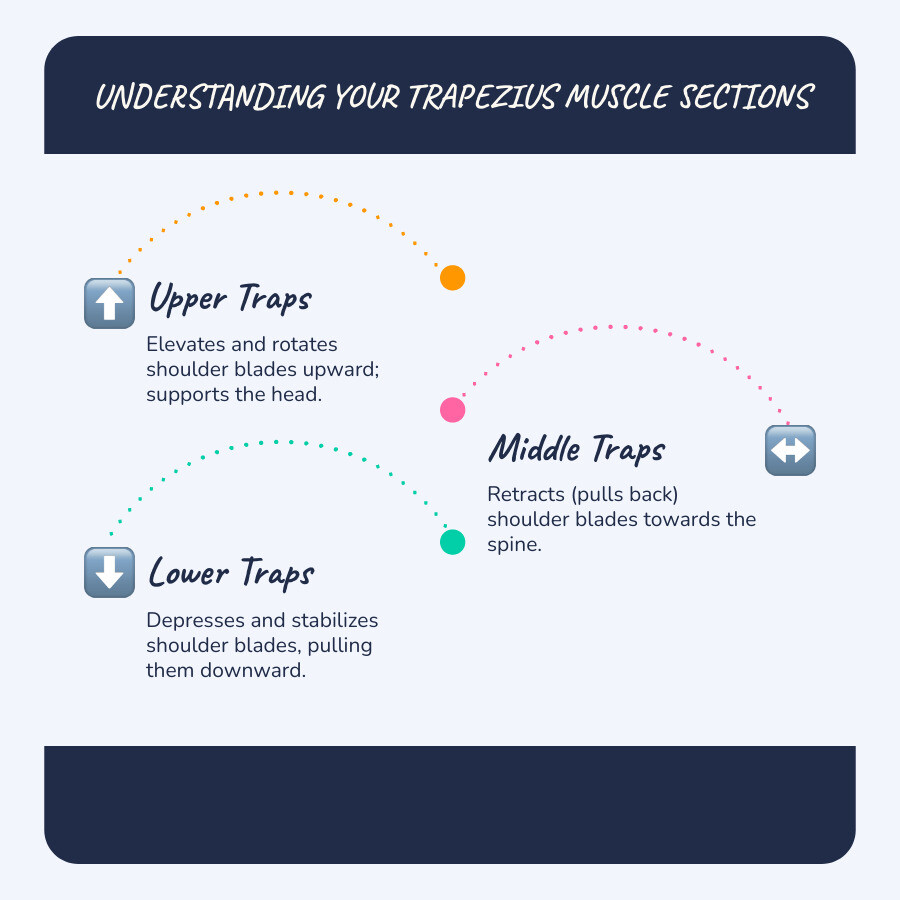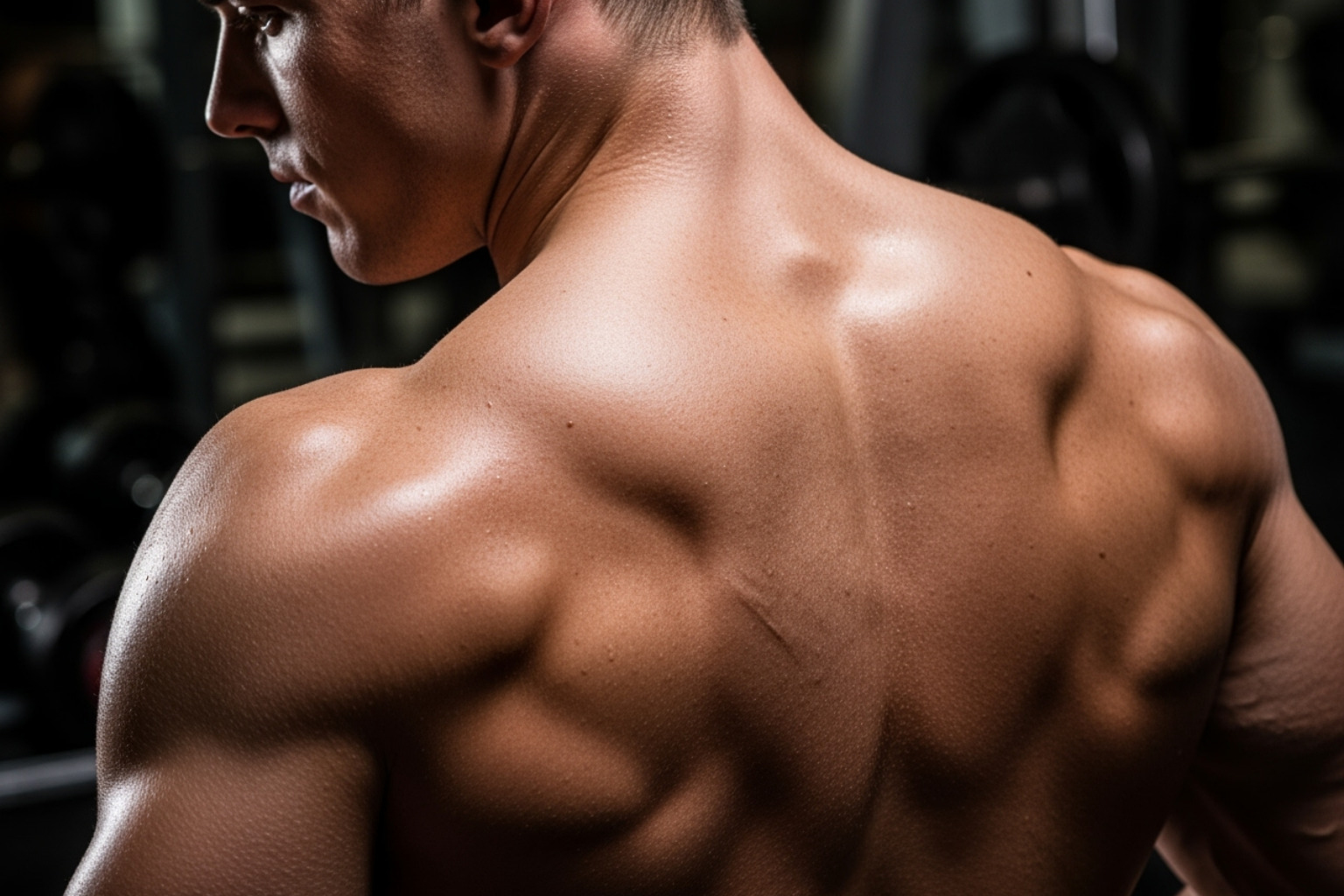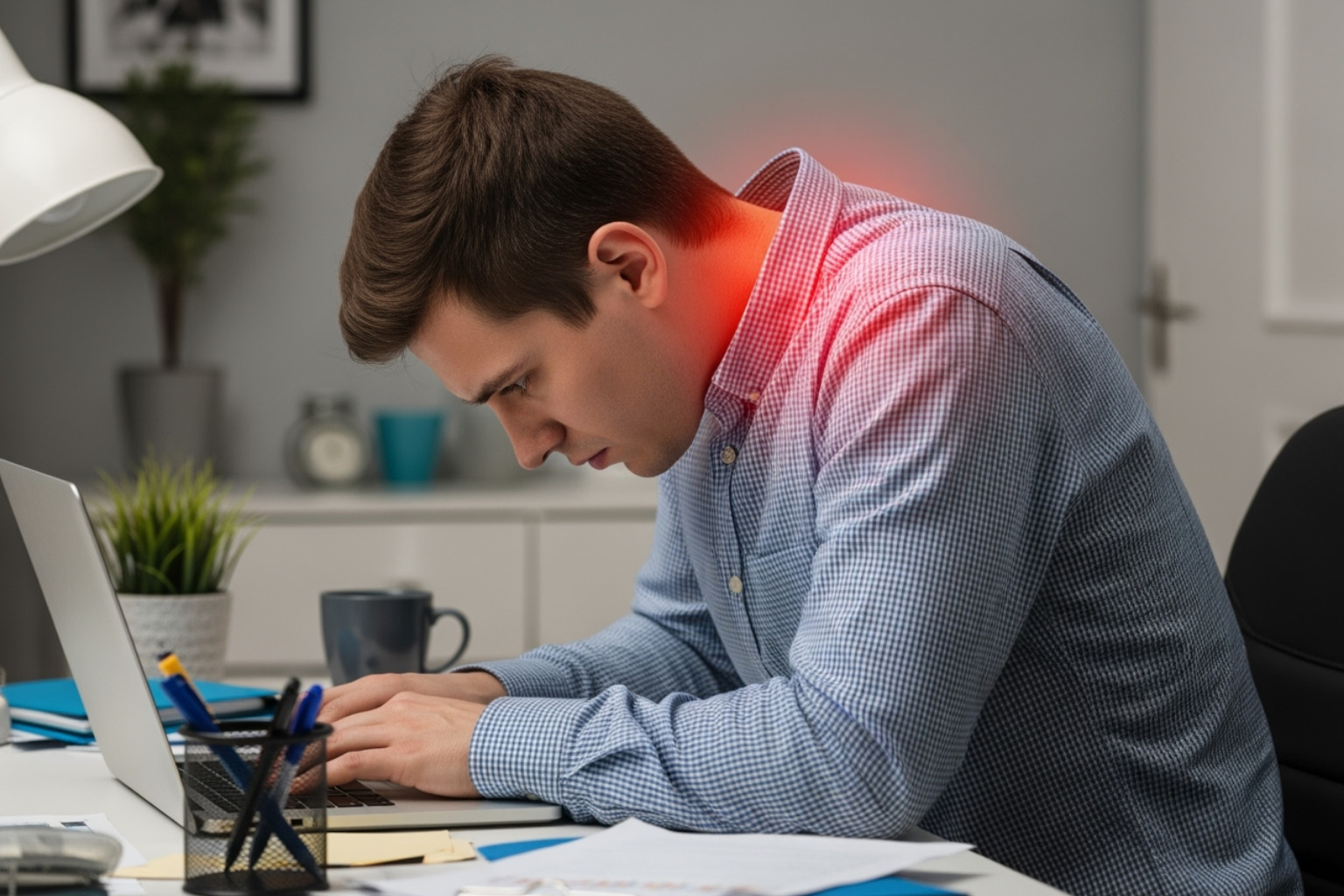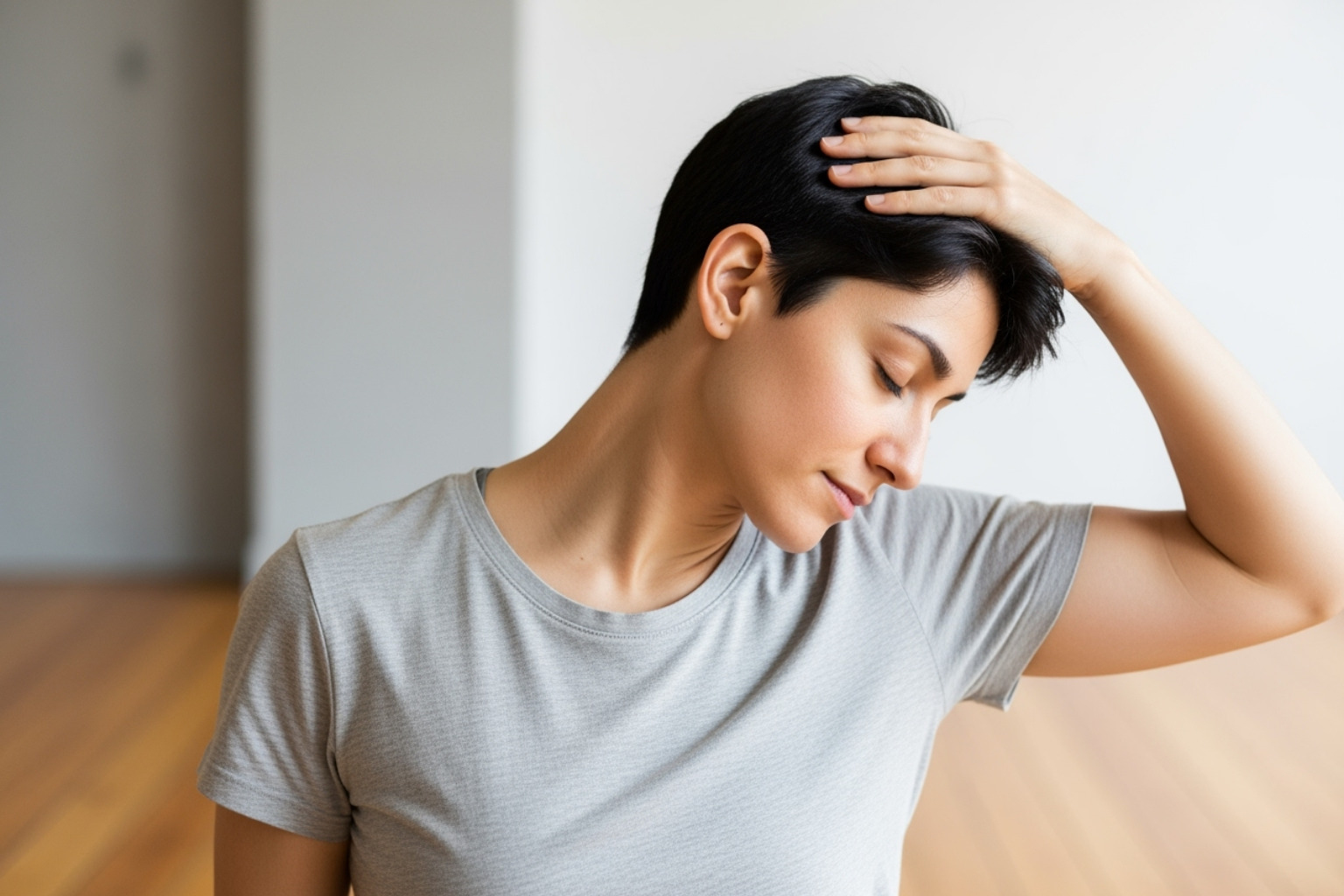What Are Muscle Traps and Why Do They Matter?
Muscle traps, or trapezius muscles, are the large, diamond-shaped muscles stretching from your skull to your mid-back and across your shoulders. They work constantly to support your head, stabilize your shoulders, and maintain posture, whether you're sitting at a desk or carrying groceries.
These muscles are divided into three sections:
- Upper Trapezius: Lifts the shoulders (shrugging).
- Middle Trapezius: Pulls the shoulders back.
- Lower Trapezius: Pulls the shoulders down.
Because they are so active, the traps are one of the most frequently stressed muscles in the body. Hunching over a computer or craning your neck to look at a phone puts a significant toll on them. When healthy, they support good posture and pain-free movement. When tight or strained, they can cause headaches, neck pain, and limited motion.
Understanding your trapezius muscles is the first step toward relief, whether you're an athlete, a desk worker, or anyone dealing with neck and shoulder discomfort.
I'm Tony Enrico, and at Neuropasil, we've helped thousands find relief from muscle and nerve pain, including persistent muscle traps pain. Our mission is to help everyone move freely and live without being controlled by pain.

Understanding the Anatomy of Your Trapezius Muscle
Your trapezius is a large, superficial skeletal muscle, meaning it sits close to the skin, where you can often feel tension building. It's one of the hardest-working muscles in your body, constantly active to support your upper back, neck, and shoulders. For a detailed medical overview, see the Anatomy, Back, Trapezius - StatPearls article.

Location and Structure
The trapezius gets its name from its trapezoid shape. Together, the two trapezius muscles (one on each side of the spine) form a large diamond. This muscle starts at the base of your skull (occipital bone), extends down to your mid-back (lower thoracic vertebrae), and spreads across to your shoulder blades (scapula) and collarbone (clavicle). This extensive network of connections makes it a powerhouse for upper body movement.
The Three Sections of the Muscle Traps
The trapezius functions like three muscles, each with a specific job:
- The upper trapezius (superior fibers) runs from the skull and neck to the collarbone. These are the fibers you feel when you massage the area where your neck meets your shoulder.
- The middle trapezius (transverse fibers) runs horizontally from your spine to your shoulder blades, helping you pull your shoulders back.
- The lower trapezius (inferior fibers) starts at your mid-back and angles up to the shoulder blade, playing a key role in shoulder stability.
Functions and Movements of the Muscle Traps
Your trapezius is involved in nearly every upper body movement, making it prone to strain.
- Shoulder Elevation (Shrugging): The upper trapezius lifts your shoulders, whether you're carrying a heavy bag or tensing from stress.
- Scapular Retraction: The middle trapezius pulls your shoulder blades together, which is essential for good posture.
- Scapular Depression: The lower trapezius pulls your shoulder blades down, stabilizing them during overhead movements like reaching or throwing.
- Head and Neck Movements: The upper trapezius assists in tilting and turning your head.
- Postural Support: All three sections work together to hold your head up and keep your shoulders properly aligned.
When your muscle traps are working well, you don't notice them. When they're strained, everything becomes harder. For more on how this impacts you, see our guide on Shoulder Muscle Pain.
Common Causes and Symptoms of Muscle Traps Pain
Given their constant workload, it's no surprise that muscle traps are a common source of pain. While not as prone to major injury as other muscles, trapezius discomfort is widespread and can significantly impact your quality of life. The causes range from daily habits to sudden injuries.

Why Do My Traps Hurt? Common Culprits
- Stress and Tension: When we're stressed, we unconsciously tense our shoulders, causing the trapezius muscles to become chronically tight and fatigued.
- Poor Posture: Hours spent hunched over a desk or looking down at a phone (often called "tech neck") puts immense strain on your muscle traps as they work overtime to support your head. The Cleveland Clinic offers valuable insights into posture issues.
- Overuse and Strain: Repetitive movements, heavy lifting, or intense workouts can cause microscopic tears in the muscle fibers, leading to pain and inflammation.
- Acute Injuries: Sudden trauma, such as whiplash from a car accident, a fall, or a sports collision, can cause immediate and severe trapezius pain.
- Nerve Compression: A pinched nerve in the neck or upper back can refer pain to the trapezius, sometimes causing tingling or numbness down the arm.
Recognizing the Symptoms
When your muscle traps are unhappy, they'll let you know with a variety of symptoms:
- Stiffness: A feeling of tightness or restricted movement when turning your head or rolling your shoulders.
- Upper Back and Neck Pain: This can be a dull, persistent ache or a sharp, stabbing pain that radiates across the shoulders.
- Tension Headaches: Pain that starts in the neck and upper traps can travel up the back of your head, causing a throbbing or pressure sensation.
- Muscle Spasms: Sudden, involuntary, and painful muscle contractions that limit movement.
- Knots or Trigger Points: Tender, tight bands of muscle that are painful to the touch and can refer pain to other areas.
- Reduced Range of Motion: Difficulty with simple movements like turning your head or reaching overhead.
If you're experiencing these symptoms, your body is signaling that your muscle traps need attention. For a deeper look at this issue, read our guide on muscle tension.
How to Keep Your Trapezius Muscles Healthy and Pain-Free
Proactive care is key to preventing pain in your muscle traps. A combination of stretching, strengthening, and smart pain management can make a huge difference in your daily comfort. Think of it as regular maintenance for some of the hardest-working muscles in your body.

Stretches for Trapezius Relief
Regular stretching improves flexibility, reduces stiffness, and increases blood flow. As recommended by sources like the American Heart Association, move gently into each stretch, hold for 15-30 seconds without bouncing, and stop if you feel sharp pain.
- Ear-to-Shoulder Stretch: Gently tilt your head, bringing your ear toward your shoulder to stretch the upper trapezius. Repeat on the other side.
- Cat Stretch: On all fours, arch your spine up toward the ceiling, tucking your chin. Then, let your belly sink as you lift your head. This mobilizes the entire back.
- Hug Stretch: Reach one arm across your chest to grasp the opposite shoulder. Gently press down on the shoulder while leaning your head to the opposite side. Switch sides.
- Gentle Neck Rotations: Slowly turn your head from side to side, looking over each shoulder to maintain mobility.
Strengthening Exercises for a Stronger Back
Strengthening your muscle traps builds long-term resilience against strain. Focus on balanced development across all three sections to avoid creating imbalances.
- Scapular Pull-ups: Hanging from a bar, pull your shoulder blades down and together, lifting your body a few inches. This targets the lower and middle traps.
- Inverted Rows: Lying under a sturdy bar, pull your chest toward it while squeezing your shoulder blades. This builds functional pulling strength.
- Y-T-W Raises: Lie face down and lift your arms to form a "Y," then a "T," and finally a "W" shape. These are excellent for the often-neglected middle and lower traps.
- Push-ups: A classic exercise that engages the trapezius muscles for stability. Focus on maintaining a straight body line and controlled movement.
At-Home Pain Management Strategies
When pain strikes, these at-home strategies can provide relief.
- Rest and Gentle Movement: Avoid activities that aggravate the pain, but don't become completely sedentary. Light, pain-free movements and stretches can prevent stiffness.
- Ice and Heat: For an acute injury, the Mayo Clinic advises using ice for the first 24-48 hours to reduce inflammation. Apply for 15-20 minutes at a time. After that, you can switch to moist heat (like a warm compress) to relax tight muscles and improve blood flow.
- Targeted Topical Relief: For fast-acting comfort, we developed Neuropasil Pain Relief Cream. Our formula uses natural ingredients—Aloe, Urea, and Menthol—to deliver soothing relief directly to your sore muscle traps. The Menthol provides a cooling sensation that calms irritated nerves, while Urea helps the ingredients penetrate deeply. Neuropasil absorbs quickly without a greasy feel. Simply massage it into your neck, shoulders, or upper back when pain strikes. For more on how topical solutions help, see our Expert Guide to Topical Treatments for Muscle Aches.
When to Seek Professional Help for Trapezius Pain
While many cases of trapezius pain resolve with self-care, some symptoms warrant professional medical attention. Ignoring these signals can turn a minor issue into a chronic problem. It's always better to be cautious and consult a professional if you're unsure. You can use resources like Find a Doctor to locate a qualified provider.
When to See a Doctor
Schedule an appointment with a healthcare professional if you experience any of the following:
- Pain that lasts for more than a week despite self-care.
- Severe or worsening pain that interferes with daily activities or sleep.
- Numbness, tingling, or weakness that radiates into your arms or hands.
- Visible deformity, significant swelling, or a lump in the shoulder or neck area.
- Signs of infection, such as redness, warmth, fever, or chills.
- Inability to move your neck, shoulder, or arm through its full range of motion.
Professional Treatment Options
A healthcare professional can create a personalized treatment plan to address the root cause of your pain.
- Physical Therapy: A physical therapist can guide you through targeted exercises to correct muscle imbalances, improve posture, and restore proper movement patterns.
- Massage and Manual Therapy: Techniques like trigger point therapy can release knots and tension. Some practitioners also use supportive kinesiology taping to reduce pressure and improve muscle function.
- Dry Needling: This technique involves inserting thin needles into trigger points to release muscle knots. A 2018 study found it significantly reduced pain severity in the upper trapezius.
Your provider will develop a plan custom to your needs, combining treatments to manage pain and prevent it from returning. For more on this, explore our guide: Discover Trapezius Strain Treatment Strategies.
Conclusion: Your Partner in Pain Relief
Your muscle traps are the unsung heroes of your upper body, essential for everything from maintaining good posture to moving your head and shoulders. We've covered how to understand these muscles, recognize the signs of strain, and what you can do about it.
With consistent care—including stretching, strengthening, and smart pain management—you can keep your trapezius muscles healthy. Prevention is ideal, but when discomfort strikes, you have effective options.
For those moments when you need targeted, fast-acting comfort, Neuropasil is here to help. Our Neuropasil Pain Relief Cream was formulated for people dealing with persistent muscle tension and aches. The unique blend of natural ingredients, including soothing Aloe, penetrating Urea, and cooling Menthol, delivers relief right where you need it. Whether it's stress-related tension or post-workout soreness, our cream helps you get back to your life without pain holding you back.
While our cream provides excellent at-home relief, remember to consult a healthcare provider for severe or persistent pain. At Neuropasil, we are committed to being your partner in achieving a more comfortable, pain-free life. Take care of your body, be mindful of your posture, and know that effective, natural relief is within reach.
Ready to feel the difference? Find how Neuropasil can soothe your muscle traps.
Shop for Neuropasil Pain Relief Cream
References
This section lists the external sources cited in the text. These resources provide factual backing for the claims and information presented in this article.
- Ourieff, J., Scheckel, B., & Agarwal, A. (2023). Anatomy, Back, Trapezius. In StatPearls. StatPearls Publishing. https://www.ncbi.nlm.nih.gov/books/NBK518994/
- Cleveland Clinic. (2020). Got Back Pain? These 5 Posture-Fixing Exercises Will Help. https://health.clevelandclinic.org/posture-exercises
- Kamali, F., Sinaei, E., & Morovati, M. (2019). Comparison of Upper Trapezius and Infraspinatus Myofascial Trigger Point Therapy by Dry Needling in Overhead Athletes With Unilateral Shoulder Impingement Syndrome. Journal of Sport Rehabilitation, 28(3), 243-249. https://pubmed.ncbi.nlm.nih.gov/29364040
- American Heart Association. (n.d.). Flexibility Exercise (Stretching). https://www.heart.org/en/healthy-living/fitness/fitness-basics/flexibility-exercise-stretching
- Mayo Clinic. (n.d.). Muscle strain: Diagnosis & treatment. https://www.mayoclinic.org/diseases-conditions/muscle-strain/diagnosis-treatment/drc-20375419
- Medical News Today. (n.d.). Find a Doctor. https://connect.medicalnewstoday.com/














